|
Report from
Europe
Growth in EU hardwood plywood imports slackens
EU imports of hardwood plywood were 103.1 million
cu.m in the first five months of this year, 3.3% more than
in the same period of 2014. However, import growth has
slowed in 2015 compared to the 11.1% increase registered
for 2014 as a whole, (Chart 1).
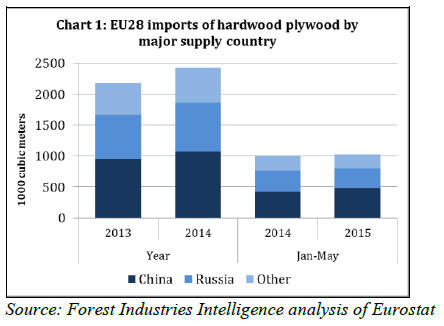
The increase in EU hardwood plywood imports between
January and May this year was due almost entirely to
higher deliveries of mixed light hardwood (MLH)
plywood from China. Hardwood plywood imports from
China - now dominated by MLH products 每 increased
13.6% to 482,400 cu.m in the first five months of 2015.
In contrast, imports of temperate hardwood plywood from
Russia (-5.3% to 323,200 cu.m), Belarus (-5.3% to 39,500
cu.m), and the Ukraine (-5.3% to 39,300 cu.m) all
declined in the first five months of 2015 after rising in
2015. Deliveries from Uruguay declined again in the first
5 months of 2015 (-17.5% to 10,900 cu.m) continuing the
sharp downward trend registered in 2014 (Chart 2).
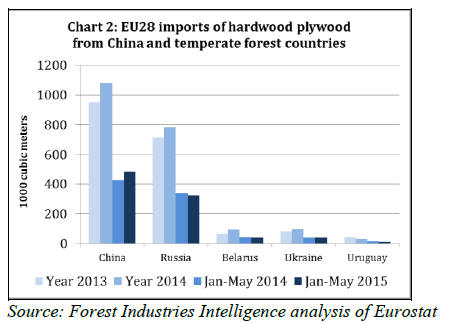
Chinese hardwood plywood performing well in UK and
Benelux region
Continued growth in Chinese hardwood plywood
deliveries to Europe in 2015 is almost entirely due to three
countries: the UK, Belgium and the Netherlands (Chart 3).
The UK remains China‟s most important European
market. UK imports jumped 25.6% to 247,900cu.m in the
first five months of this year, after a 10.7% increase in
2014 as a whole.
Roughly half of all China‟s hardwood plywood deliveries
to the EU market are now destined for the UK (Chart 3).

The recovery in Chinese hardwood plywood imports
observed in Belgium and the Netherlands in 2014 has
continued into 2015. Imports into the Netherlands
increased 105% to 36000 cu.m in the first five months of
this year. During the same period imports into Belgium
increased 14% to 69,900 cu.m.
In contrast, Chinese hardwood plywood imports into
France fell 20.8% to 28,500 cu.m between January and
May 2015, while those to Poland declined 13.4% to
23,500 cu.m.
German customs dispute disrupts Chinese plywood
trade
German imports of hardwood plywood from China
continue to be affected by a dispute between the German
trade and customs officials. In the last three years, customs
officials, particularly at the port of Bremerhaven, have
been checking Chinese plywood to ensure that boards are
cross-laminated rather than laid parallel to each other.
According to German customs, boards should be
reclassified as LVL if not fully cross-laminated.
This is frequently the case with lower-quality Chinese
plywood manufactured using small veneer pieces for the
cores. LVL incurs a higher rate of duty of 10% compared
to 7% for plywood. According to EUWID, roughly 40% of
Chinese hardwood plywood deliveries into Germany were
reclassified in this way in 2012.
German import merchants and the timber trade federation
GD Holz have held talks with German customs to try to
more clearly define which products should be considered
plywood and which LVL. According to GD Holz, these
talks have been unproductive so far and customs continue
to reclassify Chinese plywood. Several German importers
have now filed lawsuits and results are still pending.
At the same time, GD Holz report that since 2014, several
importers have been reimbursed for some instances of
excessive duty paid. However, customs has not revealed
why reimbursements were offered in some cases but not in
others.
The uncertainty created by the dispute in Germany may
partly explain the recent rise in imports of Chinese
hardwood plywood into ports in Belgium and Netherlands.
German buyers may be avoiding excess duty by buying
from stocks landed in these neighbouring European
countries.
The reclassification process has led to inconsistencies in
the statistical data on German hardwood plywood imports.
Data derived from Eurostat (used in Chart 3) indicates that
German imports fell by 18.3% to 34,700 cu.m in the first
five months of 2015. This followed a decline of 5.5% to
103,000 cu.m for the whole year 2014.
However, the Eurostat data deviates from figures
published by the German Federal Statistical Office
(Destatis) which indicate a 62% increase in German
hardwood plywood imports from China in the first quarter
of 2015. On enquiry, Destatis note that they have adjusted
their data downwards for 2014 to take account of plywood
reclassified as LVL.
However Destatis have not yet made the same adjustment
to the 2015 data. As a result, Destatis data on deliveries to
Germany appear to surge this year. Overall, once all
adjustments are made, Destatis reckon German imports of
Chinese hardwood plywood in the first five months of
2015 were probably around the same as last year.
Chinese plywood readily available
European importers report that Chinese plywood has been
readily available during 2015 and that delivery times to
Europe currently stand at around 4 to 5 weeks. The
dominant issue for traders in the Eurozone is the rising
cost of imports, especially since December 2014, due to
the dramatic loss in value of the euro against the US
dollar.
Against this background, Chinese producers lowered their
prices by an average of US$5-10/cu.m earlier this year.
FOB prices have now stabilised at this new level.
However, CIF prices for delivery of Chinese plywood to
Europe have continued to fall due to an unexpected slump
in freight rates in March/April after a slowdown in China‟s
overall trade. According to information from importers,
freight costs per 40ft container from China to Central
Europe temporarily fell to less than US$500, before
stabilising at around US$700 in July.
By contrast, rates in July 2014 stood at more than
US$1200 per 40ft container. Shipping companies are
currently pushing to increase prices to more than US$1000
per container for shipments in August.
Mixed fortunes for Russian hardwood plywood
Russian hardwood plywood deliveries to the EU totalled
323,198cu.m in the first five months of this year, down
5.3% compared to 341,328cu.m in the same period of
2014. Deliveries to Germany, the largest single market,
declined 18% to 70,320cu.m (Chart 4).
German imports fell particularly sharply in the first quarter
due to stock build up at the end of 2014 when several
companies ordered extra volumes to fulfil their purchasing
quotas and receive related bonuses. However German
consumption has remained stable and imports recovered a
little in the second quarter.
In the first five months of 2015, Italy (+14.7%), Latvia
(+22.7%), and Poland (+10.7%) all imported more
plywood than in the same period in 2014. In contrast,
deliveries to the UK (-4.9%), Estonia (-5.4%), Finland
(5.5%) and the Netherlands (-9.8%) were all lower than
one year ago.
European importers report that availability of Russian
birch plywood has been good this year. There were
widespread reports of overstocking at Russian mills earlier
in the year. However the supply situation is gradually
becoming better balanced as some smaller producers have
reduced production and demand has picked up in export
markets.
This has been boosted by price concessions of up to 20%
granted by Russian producers and the sharp loss in value
of the rouble against the euro. Prices are now beginning
firm again, according to importers.
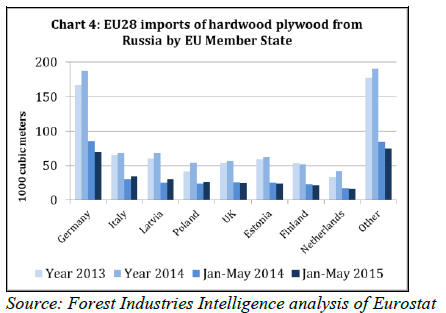
Imports from Malaysia stabilise while Indonesian boom
comes to an end
After a significant shift away from Malaysian plywood in
favour of Indonesian and Chinese product in 2014, EU
imports of plywood from tropical countries have stabilised
this year (Chart 5).
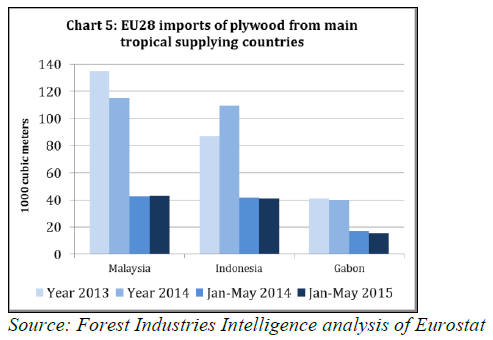
European imports of Malaysian plywood declined 14.8%
to115,300 cu.m in 2015. Some of this decline was
explained by relatively low purchases at the beginning of
the year. Malaysia lost its GSP status on 1 January 2014
and European importers had built up stocks of plywood
imported at preferential taxes in advance.
European importers also note that Malaysian producers
lost market share to China. Although Chinese plywood
products are, on average, considered lower quality than
Malaysian products, prices are considerably lower.
At the same time, European importers note that good
quality, controlled and certified product ranges 每 for
example BM Trada Q-Mark 每 can now be obtained in
China at roughly the same price as Malaysian standard
plywood. This type of material has also gained market
share from Malaysian products.
Total Malaysian plywood deliveries to Europe in the first
five months of 2015 were 43,000cu.m, very similar to the
same period in 2014. However, there was a shift in the
destination of product, with a rise in shipments to Belgium
offsetting a slight decline in deliveries to the UK,
Netherlands, Denmark and other countries (Chart 7).
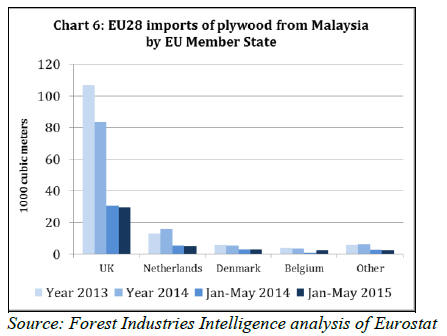
EU plywood imports from Indonesia increased 25.7% to
109,700 cu.m in 2014. Imports were 41,200 cu.m in the
first five months of 2015, only 1.7% below the higher
level achieved in the same period last year. However, as
for Malaysian plywood, there has been a shift in the
direction of European trade in Indonesian plywood this
year.
Deliveries of Indonesian plywood to Belgium and the UK,
the two largest European markets for this commodity,
have continued to grow in 2015, but less rapidly than in
2014. There has also been a pronounced slow-down in
deliveries to the Netherlands in 2015. Deliveries to this
market rose 31.5% in 2014 but fell back by 46.2% in the
first five months of this year.
A similar trend is seen in Germany, where imports of
Indonesian plywood increased 15.5% in 2014 but fell
15.7% between January and May of this year (Chart 6).
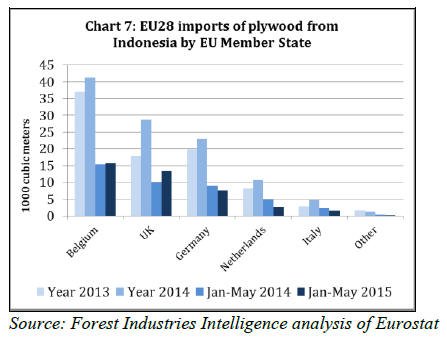
European importers note that Indonesian and Malaysian
plywood have been at a disadvantage compared to Russian
material in the Eurozone this year, as the US dollar has
strengthened against the euro while the rouble has
weakened considerably. While Russian producers have
been able to reduce their euro-denominated sales prices,
prices for South-East Asian plywood, which is traded in
US dollars, have increased for buyers in the Eurozone.
This development has been particularly significant for
thicker panels of 12mm, 15mm, 18mm or 21 mm.
European demand for thinner Asian hardwood panels
(4mm and 8mm) has been less affected by the trend
according to importers.
European demand for okoum谷 plywood remains low
In 2015, European imports of okoum谷 plywood from
Gabon have declined further from the low levels recorded
in 2014. European imports of Gabonese plywood declined
8.9% to 15,700 (17,200) cu.m in the first five months of
2015, following a 2.6% fall to 40,200 cu.m in 2014.
Although there has been some small recovery in the main
Dutch and Italian markets for okoume plywood in 2015,
this has been offset by a decline in sales to France and
Belgium (Chart 8).
The French company Rougier, which operates plywood
and veneer mills in Gabon, attributed its 3% lower
plywood sales in the first quarter of 2015 to the continuing
※unfavourable environment in European markets§,
according to the financial report.
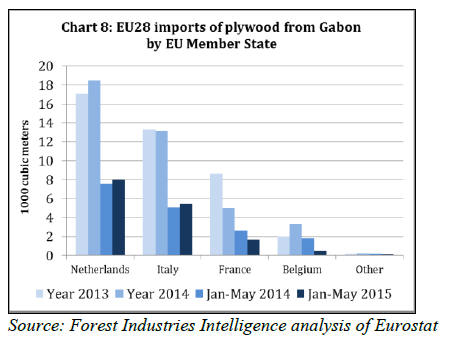
Opportunities for Chinese producers to engage in Europe‟s
okoume plywood market may open up again in 2016.
Since 2 February 2011, four Chinese plywood
manufacturers have been subject to anti-dumping duties of
between 6.5% and 23.5% on their exports of okoume
plywood to the EU, while all other producers have been
subject to 66.7% duty.
In a notice issued on 14 May 2015, the EU announced that
these anti-dumping measures would be lifted at midnight
on 3 February 2016. This is according to the schedule of 5
years after the date of the original ruling in 2011. However
EU producers may yet appeal against the lifting of the
duties. They have until 2 November 2015 to lodge a
written request for review.
According to the EU, this request must ※contain sufficient
evidence that the expiry of the measures would be likely to
result in a continuation or recurrence of dumping and
injury§. The notice is available at:
http://trade.ec.europa.eu/doclib/docs/2015/may/tradoc_153
444.imp-exp.en.C161-2015.pdf
New Chilean softwood plywood capacity reaches
Europe
EU softwood plywood imports during 2014 increased
12.5% to 777,400 cu.m in 2014. Growth in imports has
continued this year, although at a slower rate. In the first
five months of 2015, imports increased 5.9% to 823,100
cu.m, mainly due to higher imports from Chile and Russia.
European imports of softwood plywood from Brazil, still
by far the largest supplier, were stable at 584,600 cu.m
(Chart 9).
In Chile, the two largest plywood producers Paneles
Arauco and Empresas CMPC both brought additional
production capacity online in 2014. The extra volume now
available is reflected in a 62.1% increase in EU softwood
plywood imports from Chile in the first five months of
2015.
Arauco reports higher production and stable prices for its
plywood products in the company‟s financial report for the
first quarter of 2015. CMPC says its plywood production
increased by 70% in the first quarter, thanks to better
utilisation of its new production line.

For Brazilian plywood, European importers are reporting
exchange rate and demand-related uncertainty. Elliotis
pine plywood is typically traded in US dollars with the
result that weakening of the euro-dollar rate made the
Brazilian product more expensive for European buyers in
the early months of 2015.
However this is now being offset by reductions in FOB
prices and a further decline in freight rates this year. The
loss in value of the Brazilian real against the US dollar has
given producers some space to reduce dollar prices in
recent months. As a result, importers say that elliotis pine
plywood 每 after import tax 每 has recently been cheaper
than plywood ordered as a part of the duty-free quota
earlier in 2015.
Availability is currently not a problem in the softwood
plywood trade. On the contrary, European importers report
that stocks of elliotis pine plywood are still high in several
EU countries. Stocks are also reported to be readily
available from Brazil as both the domestic and some
export markets have slowed in 2015.
UK weaker, but Germany rebounds
Within Europe much of last year‟s growth in softwood
plywood imports was due to the strengthening UK market,
which imported a total of 420,700 cu.m, 22.5% more than
in 2013. This trend reversed in the first five months of
2015, as UK imports fell 4.1% to 221,800cu.m. In
contrast, imports into Germany, the second largest
European market, increased 18% to 213,300cu.m during
the same period. Imports of softwood plywood also
increased into Belgium (+6.1%), Italy (+21,2%) and the
Netherlands (+19,7%) (Chart 10).
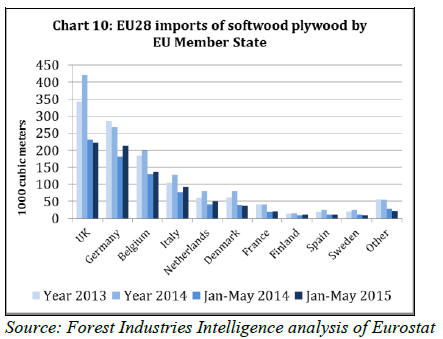
Prospects for the European markets still uncertain
While plywood importers are generally satisfied with the
market situation in Central and Northern Europe in the
first half of 2015, there is still uncertainty about the future.
There is particular concern about the French market which
has again disappointed in recent months. But other
markets are also being slow to pick up momentum this
year.
After a brief growth spurt in 2014, the Eurostat
construction production index has largely stagnated 每in
some months even softened a little 每 from the level
reached in June 2014. The index value in all large EU
countries with the exception of Poland, Germany and the
UK is still below 100 每 in other words construction
production is lower than in the base year 2010. The
Netherlands is the only construction market to have made
significant gains so far in 2015 (Chart 11).
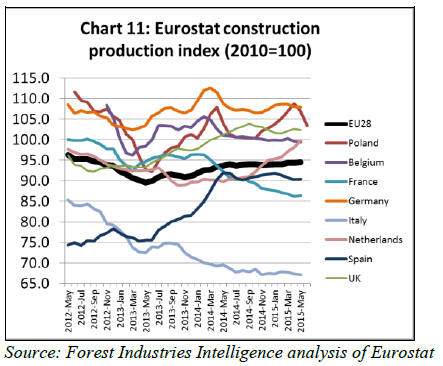
Uncertainty in Europe‟s plywood trade is also fed by
exchange rate fluctuations 每 especially in relation to the
euro against the background of severe economic problems
in Greece. Container rates remain volatile. There are also
continuing reports of slowing economic conditions in
other major consuming countries, including China and
Russia, raising the prospect that prices might weaken in
the future. Taken together, these factors continue to
discourage more far-reaching moves by European
plywood importer to build stocks.
|